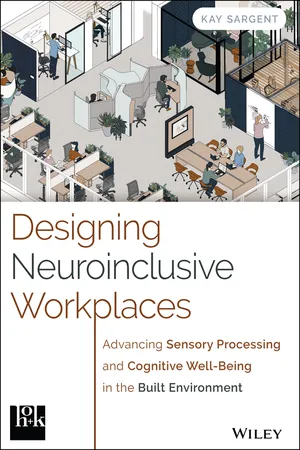
Designing Neuroinclusive Workplaces
Advancing Sensory Processing and Cognitive Well-Being in the Built Environment
- 351 pages
- English
- PDF
- Available on iOS & Android
Designing Neuroinclusive Workplaces
Advancing Sensory Processing and Cognitive Well-Being in the Built Environment
About this book
Assist the growing neurodivergent population with strategic adjustments to physical spaces
Designing Neuroinclusive Workplaces: Advancing Sensory Processing and Cognitive Well-Being in the Built Environment explores how to employ strategic spatial zoning and sequencing, sensory zones, patterns, textures, colors, lighting, and soundscaping to create spaces that cater to the various sensory needs of neurodivergent individuals, who now make up 1/5 of the world's population. This group possesses unique strengths that can be harnessed if they are in environments designed to be welcoming and supportive of their needs.
Written by Kay Sargent of HOK, a leader in the field of workplace design and architecture, this groundbreaking book argues that even minor adjustments to physical spaces can drive giant improvements in cognitive function, fulfillment, and belonging for both neurodivergent and neurotypical individuals.
Some of the topics explored in this book include:
- Reimagining the design of offices and workplaces through a neuroinclusive lens
- Optimizing spaces to accommodate hypersensitivities across all six work modalities, ranging from focused tasks to collaborative endeavors
- Inclusion practices to boost productivity in the workplace and transform high-stress environments into more welcoming and functional spaces for everyone
Filled with practical, actionable strategies for designing spaces that embrace and empower individuals across the neurodiversity spectrum, Designing Neuroinclusive Workplaces is a timely, essential read for all forward-thinking HR, DEI, and accessibility teams, as well as architects and interior designers.
Frequently asked questions
- Essential is ideal for learners and professionals who enjoy exploring a wide range of subjects. Access the Essential Library with 800,000+ trusted titles and best-sellers across business, personal growth, and the humanities. Includes unlimited reading time and Standard Read Aloud voice.
- Complete: Perfect for advanced learners and researchers needing full, unrestricted access. Unlock 1.4M+ books across hundreds of subjects, including academic and specialized titles. The Complete Plan also includes advanced features like Premium Read Aloud and Research Assistant.
Please note we cannot support devices running on iOS 13 and Android 7 or earlier. Learn more about using the app.
Information
Table of contents
- Cover
- Title Page
- Copyright Page
- Contents
- Foreword
- Preface
- Chapter 1 Framing the Issue
- Chapter 2 Defining Neurotypes
- Chapter 3 Great for Business
- Chapter 4 Human Functioning and Sensory Processing
- Chapter 5 Sensory Intelligence
- Chapter 6 Survey Findings
- Chapter 7 Senses and Degree of Stimulation
- Chapter 8 Environmental Influences
- Chapter 9 Other Elements to Consider
- Chapter 10 Degrees of Inclusive Design
- Chapter 11 HOK’s Approach to Inclusive Design
- Chapter 12 Steps Toward Designing for Inclusion
- Chapter 13 Design Considerations
- Chapter 14 The Three-Legged Stool
- Chapter 15 Going Forward
- Afterword: Call to Action
- Notes
- Acknowledgments
- About the Author
- What We Do
- Index
- EULA